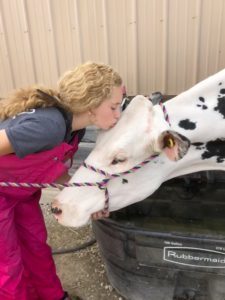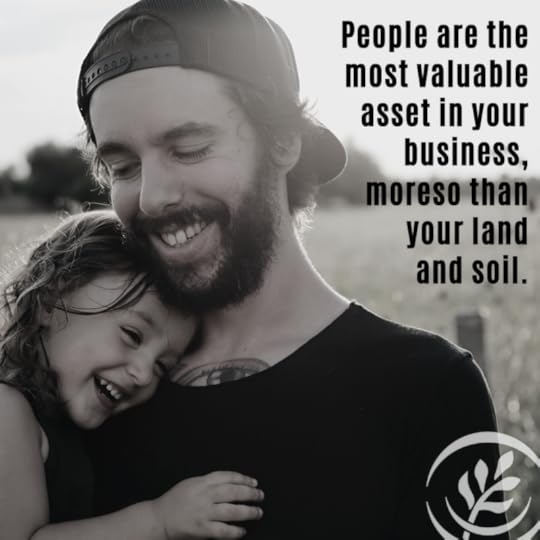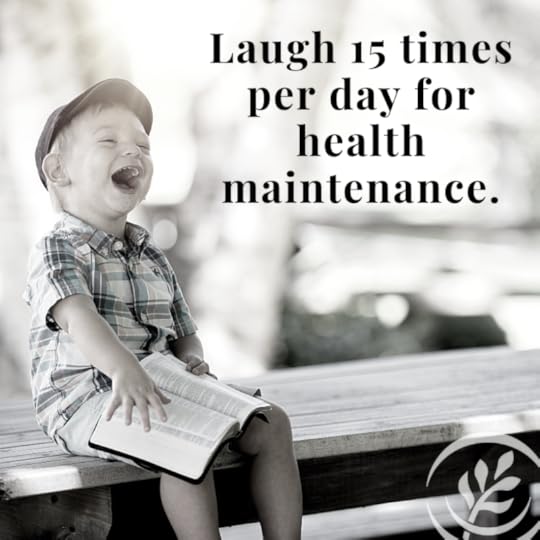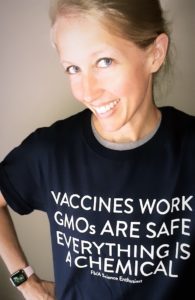Michele Payn's Blog, page 6
June 23, 2020
A farm kid’s perspective: Episode 48
Life on the farm may be a mystery for those of us in urban and suburban areas. One of the best ways to understand where food comes from is to meet the people who grow it. Farm kids balance school, sports, service clubs, and helping on the farm. In this behind the scenes episode, meet our Food Bullying Podcast editor and find out about her life as a farm kid. She shares what she’s learned showing dairy cattle in 4-H, including how stubbornness and leverage can move a ton.
 Audrey will soon be a junior in high school and loves her Holsteins. She is an avid runner, competing in cross country and track. Audrey is a busy, high-achieving student who is also active in 4H and FFA – and wishes people understood that not all farmers fit a mold.
Audrey will soon be a junior in high school and loves her Holsteins. She is an avid runner, competing in cross country and track. Audrey is a busy, high-achieving student who is also active in 4H and FFA – and wishes people understood that not all farmers fit a mold.
She also describes a very successful FFA effort to solve two problems in her community. Through a milk and meat campaign that raised more than $34,000, her FFA chapter purchased meat and milk from local farmers to be distributed to seven local food banks during the pandemic and following months.
Listen in for an inside look from a teenager on the farm.
Links:
Food Bullying Podcast’s Facebook Page: https://www.facebook.com/foodbullyingpodcast
Food Bullying: How to Avoid B.S. by Michele Payn: http://foodbullying.com
Embrace Your Heart with Eliz Greene: http://www.embraceyourheart.com/
June 16, 2020
Does an expensive steak taste better? Episode 47
Does how you feel about a cut of steak or whether it is labelled “natural” impact how much you enjoy it? Our guest, Dr. Mark Miller shares his research on consumer beef preferences and how labels influence what we choose to eat.
Dr. Mark Miller is the San Antonio Livestock Show Distinguished Chair in Meat Science at Texas Tech University. He has been instrumental in developing consumer thresholds for beef and holds two patents for the processes that improve beef tenderness and color with electrical stimulation. He is also passionate about meat judging and has coached numerous teams to seven national championships.
Key points:
How does price impact how we feel about the value of a product?
Consumer preferences are the most important things to meat science.
There is no good food or bad food. People’s preferences to eat or not eat are always right.
It is the amount of foods or “dose” that can make the difference.
Companies are trying to create market share through labels and messaging appealing to niche markets:
“Natural” production claims have increased by 40%
Organic production costs 25 – 30% more than conventional production.
We should allow the market rather than marketing to decide what should be grown and produced.
Food production has to be affordable to everyone.
Why would people pay so much more for beef than other meats?
Beef is more expensive than chicken or other meats
Eating a great cut of beef releases they same type of hormones in the brain as falling in love. It is very satisfying.
How do labels influence how we perceive beef?
In an experiment, people rated several cuts of beef on tenderness, taste etc.
Then they were fed the exact same cuts but they were labeled with terms such as organic, natural, hormone treated, etc.
The labels created a bias that effected the enjoyment of the beef.
What is the difference between conventional and grass-fed beef?
New Zealand and Southern Australia are the best place in the world for grass production. They have grass in abundance and a favorable climate.
In the U.S. there are only about 120 days per year that animals can graze.
Grass-fed animals take 2.5 – 3 years to grow large enough.
In the US we have corn and soy beans in abundance.
Conventional fed animals grow to the same size in 14 months.
Grass-fed beef is more expensive to produce. It costs about $8 per pound compared to $2.90 per pound for conventional beef.
The carbon foot print of conventional beef is about 45% of grass fed beef.
Cattle like grain over grass.
What should we know about hormones in beef?
In the U.S. we’ve been using hormones in beef production since 1957.
We’ve already done the human case study for nearly 70 years. There is not a single documented case of any health concern as a result.
The additions of naturally occurring testosterone or estrogen encourages muscle growth.
The amount of estrogen in cabbage is far greater than in treated beef.
Anti-science propaganda make it sound scary.
Working with Dr. Tyler Davis (featured in two previous episodes) on understanding reactions to marketing labels was life changing.
Food choices create an emotional response.
Eating something that tastes bad creates a reaction that will last forever. A great eating experience lasts too.
3 tips to overcome food bullying:
Enjoy your point of view based on what you like to taste and eat. Don’t feel guilty.
There are no good foods or bad foods. It is all about how much you eat.
Don’t believe anything that isn’t backed up by a peer-reviewed scientific study.
 Links:
Links:
Mark Miller: mfmrraider@aol.com
Tyler Davis Episodes:
Is your emotional brain being tricked by food marketers? Episode 16
Ho w is your brain being manipulated about food?
Food Bullying Podcast’s Facebook Page: https://www.facebook.com/foodbullyingpodcast
Food Bullying: How to Avoid B.S. by Michele Payn: http://foodbullying.com
Embrace Your Heart with Eliz Greene: http://www.embraceyourheart.com/
June 11, 2020
H.O.P.E. for Agriculture

Consider the hours you’ve spent in the field or barn carefully monitoring your crops or animals. You likely spent time assessing the environment, diagnosing problems, and considering improvements.
When was the last time you did the same for yourself? What if we cared for the people of agriculture the same way we do with the products we grow? We often adopt an attitude of “let’s not talk about it” when it comes to mental health, embracing the idea of “pull yourself up by your bootstraps.” That’s topped off with “I don’t need any help” in the independent culture of farming, ranching, and every business who supports food production.
Data clearly shows that’s not working in the face of a global pandemic, constantly changing markets, weather problems, and all of the pressures piled on farmers and ranchers. You’ve likely read about suicide rates; the people of agriculture have to get better at self-care so we quit losing loved ones. If you know of someone who is considering harming themselves, or you’d like tools, please see this list of mental health resources.
Let’s be honest – the stigma surrounding mental health in agriculture doesn’t allow us to openly address the problem or offer solutions. Here’s some H.O.P.E. to help:
H = Health
Eat right, sleep right. These are the same answers given by nearly every person with whom I’ve talked about their experience with depression, anxiety, death of a loved one by suicide, and mental health challenges. Remember, mental health needs to be treated the same as dealing with a broken arm, heart problems, or chronic disease. You need to proactively manage your health – all health, including what is going on between your ears.
Getting enough sleep is proven to reduce stress. If you’re not sleeping well for more than a few weeks, seek medical expertise – it matters more than most understand. If you can’t sleep, you can’t function well enough to make good self-care decisions, let alone operate well in business.
Likewise, eating food that meets your nutritional needs will also feed your mental well-being as much as it does your body. While the bag of chips may be more convenient and your favorite habit, munching on some carrots is likely to have better results for your health. If you don’t let your animals eat the least healthy feed, perhaps you shouldn’t either. Have the discipline to shake up your bad eating habits and see how much better it makes you feel after a couple of weeks.
O = Openness
Asking for help can be one of most difficult actions for an independent person raised amongst agriculture’s mindset of “take care of a problem by yourself.” Yet, being open to help can be one of the greatest gifts you can give yourself. I’ve also found that asking others for help is a gift to them.
Openness to help means that you’re willing to talk to a friend, go to a medical professional, get medical intervention when needed, and ask others to do what you cannot. While going through a divorce, I learned to suck up my pride and ask friends for help. I found they were thankful to be able to help and I was stronger for it admitting I needed help.
Life isn’t meant to be lived alone, even if you’re on a 10,000 acre ranch, can handle a $500,000 piece of farm equipment with ease, or deal with the livestock 10x your size. Be open to others. You may be surprised to find that you’re stronger for being open to help.

P = Perspective
You weren’t born a farmer, but as a human. Really. That’s an important perspective to keep in mind when balance sheets are negative, Mother Nature delivers blows, consumers question every move, and trade wars leave farm prices in the toilet. Your identity is not 100% in what you do – there is life beyond agriculture.
It’s important to maintain a human-first perspective, no matter what your role is in agriculture. Humans before business. Step away, find space between your business and personal life through hobbies (yes, you need them!), sporting events, family time, fun with friends, or alone time in your favorite place. Take time out for some pleasure to protect your health, while increasing your productivity and effectiveness.
Did you know laughing 15x/day is important for health maintenance? It activates muscles, oxygen increases in the blood, and your cardiovascular system dilates. Laughter is scientifically proven to make you feel better, plus it releases pent-up feelings of anxiety, fear, and anger. Laugh to find perspective.
E = Exercise
Yes, get your heart pumping is part of the H.O.P.E. equation. “Physical activity helps bump up the production of your brain’s feel-good neurotransmitters, called endorphins,” according to the Mayo Clinic. “Regular exercise can increase self-confidence, it can relax you, and it can lower the symptoms associated with mild depression and anxiety. Exercise can also improve your sleep, which is often disrupted by stress, depression and anxiety. All of these exercise benefits can ease your stress levels and give you a sense of command over your body and your life.”
Agriculture has become much more sedentary in the last two decades, so it’s important to incorporate exercise into your day. How? You get to decide. Long walks, a home gym, going to the Y, working out with friends. My husband and I are avid cyclists, so we find new trails to enjoy together. I also have spinning and kickboxing classes as standing appointments on my calendar, in the interest of self-care being scheduled. You get to decide what works for you.
Summer is a great season to assess your self-care, diagnose problems, and consider how you can improve. I’m not asking for you to do yoga on a tractor or meditate with the cows. I am asking you to consider how H.O.P.E. can help your mental health. After all, don’t you deserve health and happiness? I think you do. How can you bring H.O.P.E. to others in agriculture?
June 9, 2020
Food allergies & food bullying: Episode 46
Did you know that people can use food to threaten others? When it comes to food allergies, food CAN kill! Our guest in this episode has great advice on how to truly welcome everyone to your table AND avoid killing someone (or making them sick) with the food you serve.
Tracy Stuckrath is a food allergy and inclusivity expert who wants to ensure no one is offended or hurt with the food they are served by others. She provides strategy and training to organizations worldwide to establish best practices, increase efficiency, increase profit, mitigate risk, and improve customer experience.
Key points:
Event professionals need to be aware and prepare for guests with food allergies.
Tracy strives to make the world healthier one event at a time.
Food and beverage makes a big difference in an attendee’s experience event. If you can’t eat the food offered, your participation is hindered:
feel hungry and not focused
can be made to feel like “a problem”
may have to leave event to get other food at their own expense
Eating is included in the ADA which gives protections to people with food allergies
events should include food allergies on registration materials
ask “How can we support you in participating in this event?”
ask about dietary restrictions and life threatening allergies
ask about preferences
need to label everything for the top 8 allergens at the least (Europe label for 14):
crustacean:crab, shrimp, prawn (EU includes molluscan shellfish
wheat (EU includes rye & barley)
egg
milk
tree nuts
peanuts (EU includes sesame and lupin)
fish
soy
(EU includes celery, mustard, sulphur dioxide & sulfites)
People with food allergies can’t “just get over it.”
Need to “eat of the same plate” and understand the experience
Newly diagnosed people struggle to figure it out and need support and compassion
If you are serving food, you have to respect the person who will eat it
Listen to needs and ask non-defensive questions
I want you to feel safe. How can I make you feel safe?
Ask for clarification
Take steps in the kitchen to avoid cross contamination. Explain what you do.
You may need to give them a gift card to buy other food
Understand airborne flour, for example, can be a problem.
Read labels – ingredients change.
Three tips to overcome food bullying when serving food to others:
ASK if people have dietary restrictions
LABEL what you are serving
CREATE a statement about being a food and beverage experience and encourage to be respectful of people’s allergies
 Links:
Links:
Tracey Stuckrath website: www.thrivemeetings.com
Facebook: www.facebook.com/thrivmeetingsevents
Twitter & Instagram: @tstuckrath & @thrivemeetings
Food Bullying: How to Avoid Buying BS by Michele Payn
Embrace Your Heart with Eliz Greene
Have you liked the Food Bullying Podcast’s Facebook page?
June 2, 2020
How do marketers influence your food buying?
Do you know how labels, ads, and menus are designed to make you buy? The job of a marketer is to get you to choose their item and sell more. Our guest Gerry O’Brion shares how giving people a rational reason to choose a product is the key to influencing buying behavior.
Gerry O’Brion is a professional speaker and branding expert who speaks to 10,000 CEOs and sales professionals every year about how big brands get customers to buy and how they can apply those principles to any industry. Gerry’s framework shows companies how to become the number one choice in a crowded market. He started his career in marketing at Procter and Gamble and was an executive for Coors Light and Red Robin.
Key points:
How do marketers influence our buying decisions?
People believe we make rational buying decisions, but that isn’t always true.
Marketers use emotional messaging and images to influence buying behavior, but emotion alone doesn’t trigger buying behavior.
Our brains need a rational reason to make an emotional decision. We need proof that our emotional decision is justified. Proof you can explain to others.
Buyer’s remorse is caused when you can’t find proof.
For food, marketing is about creating a rational hook for the decision. We want proof we are making a good/safe/better choice.
A blue liner inside a beer can that “locks in fresh brewed taste” (which is what every can liner does) was responsible for an $100 million increase in sales the first year of the marketing campaign. The liner was the rational reason to make the choice of Coors Light vs some other beer.
Understanding how marketing works allows consumers to question the rationale for choosing one product over another.
How does food marketing work in restaurants?
“Food porn” is used in video ads to create desire. For example, dripping butter on Red Lobster ads or the pizza cheese pull.
Menu design can determine what you will buy. The highest margin items can be placed to influence what people order.
Visuals and key words influence choice. If the item has organic chicken, people believe the whole dish is organic.
“House specialty” item that is unique is often the best seller.
Everything on every sign, label, menu, or ad is designed to make you buy something.
The job of executives is to make the stock price go up.
Some labels are designed to sound like a “safe” choice but has no real meaning such as “clean” or “fresh” food.
We don’t spend a lot of time making simple buying decisions and we rely on way to short cut the decision and repeat it.
Sometimes we are looking for alignment with what we believe.
In order to stand out in the millions of restaurants, they have to provide easy short cuts to align with people’s beliefs. The decision is easier and you feel good about it.
If we have a “because” we feel good about the decision. Our brains are looking for a reason to say yes. It doesn’t matter what the rational reason is… it just matters that you have one.
 Three tips to overcome Food Bullying:
Three tips to overcome Food Bullying:
Understand how you are being influenced to buy.
Do your homework. What labels are important and have meaning. (Marketers know people don’t do their homework)
Do what feels good to you.
Links:
Gerry O’Brion website: https://www.whatbigbrandsknow.com/
Food Bullying Podcast Facebook page
Food Bullying: How to Avoid Buying BS by Michele Payn
Embrace Your Heart with Eliz Greene
May 26, 2020
Dairy farmer millennial mom talks robots: Episode 44
This episode’s guest and her husband are millennials and third generation dairy, beef and crop farmers in Michigan. They are working hard and using technology, including robots, to secure the future of their farm. Ashley Kennedy shares insights on being a working mother, fostering a positive attitude toward food, and what exactly robots are doing on their farm.
Ashley Kennedy is mother to two passionate little girls, one about animals and the other about Cheerios. Ashley and her husband are third generation dairy, beef and crop farmers in Michigan. She is a long-ish distance runner usually hating herself for signing up for a half marathon. Her blog and vlog mix all of these things together by sharing about her cooking, training, farming, and mom-ing.
 Key points:
Key points:
What do robots do on the farm?
Milking robots that milk: Cows love to milk via robot, they get pick when they get milked, and some choose to milk up to 6 times per day (every 4 hours). Typically, without a robot, cows are milked on a schedule in groups.
Pushes feed to the cows all day long so they have fresh feed
Mixes formula for calves
What do you wish people would know about what you do?
It’s not just about making money.
We are passionate about our product because it is safe, wholesome, and healthy for your family and we take that very seriously.
We shop at the same store. We buy milk from the dairy case. We wouldn’t feed our children something dangerous. We wouldn’t feed your kids something dangerous either.
Happy, healthy content cows make the most milk. A comfortable cow makes more money.
We don’t make a lot of money, and don’t think about money every day. Our lives revolve around making sure our animals are safe and comfortable.
Being millennial taking over farm and raising young kids:
Before kids working 80 hours per week. Have all of the struggles of a working mom.
They were lucky her parents understood how important it was to talk about expectations were for retirement and they young couple taking on the farm. This is unusual for farming families.
Financially the transition took longer than planned, which caused stress.
Had to give farming the best try – even if they fail.
Exciting things ahead for farming with technology. She hopes to secure the future of the farm for their daughters.
How do you have a positive attitude toward food?
Sanity and mental health are important when choosing food.
Let negative feelings go.
We want to protect kids from things that will impact their health in the future, but that leads to well-intentioned mom bullying.
Milk fat became “bad for you” now the research supports dairy as part of a healthy diet.
Don’t over think it.
Our bodies and brains need carbohydrates, fat, and protein to function and grow.
Choose a few things that are important to you.
Milk fat became “bad for you” now the research supports dairy as part of a healthy diet.
Work with a registered dietitian (not a nutritionist, trainer, or someone from the gym).
A good dietitian is like a food wizard and a psychologist all in one.
Ashley is actively working on separating negative feelings from food. Packing a lunch for her kids causes guilt.
Ashley fights against the “diet culture.” Pregnancy triggered a strict diet to lose the baby weight which backfired.
Links:
Ashley Kennedy website: messykennedy.com
Facebook: facebook.com/messykennedy
Instagram & Twitter : @messykennedy
YouTube: youtube.com/messykennedy
Food Bullying Podcast Facebook page?
Food Bullying: How to Avoid Buying BS by Michele Payn
Embrace Your Heart with Eliz Greene
May 19, 2020
Why is technology in food so scary? Episode 43
We are likely to stand in line to get the latest smart phone technology — so why do we fear technology in food? In this delightful episode, Dr. Kevin Folta makes Eliz and Michele roar with laughter and sheds light on genetics, technology, and how to he’s working to make strawberries taste better. We discuss how science is working to solve important problems for people and the environment.
Kevin is a professor in plant molecular biology that publishes frequently in the genetics of fruit flavor and light regulation of plant traits. He has been a fixture in the public discussion of genetic engineering and food for almost two decades, and is recognized for his communications work with scientists and farmers. He has also hosted the weekly Talking Biotech Podcast for over 200 episodes and 1 million downloads.
Key points:
There is intellectual property in food. Like an author’s book is intellectual property, seeds and plants are created and carry the same rights.
Selective breeding is like being a “strawberry pimp.”
Genetic terms:
Genetic Modification: an imprecise term meant to convey a creepy distance from food. Scientists don’t use the term GMO.
Genetic Engineering: an imprecise term for using science to change a plant. It is better than modified. Would you rather drive across an engineered bridge or a modified bridge?
Transgenics: Specific type of engineering that changes a plant by inserting a gene from another organism. For example a bacteria to make the plant resistant to disease. It is like going to the library and putting a new book on the shelf.
CRISPR (Clustered Regularly Interspaced Short Palindromic Repeats): Specific type of engineering that involves gene editing. It is like going to the library and erasing a letter or two from one book and alter its meaning.
Genetic engineering technology is so precise that it can be tested to make sure it is doing exactly what is intended without any other effects or changes. The likelihood of side effects are very low. Only one gene is changing. Regulations require a tremendous amount of data.
Selective breeding isn’t tested and creates many collateral outcomes that are not intended. For example, corn during selective breeding often incorporate 5000 new genes.
We regulate the least risky technology to death.
Kevin has been bullied by people who have entrenched interests against technology, including non-stop freedom of information act requests and threats.
Scientists need to show how technology can solve very important problems for people and the environment. Solutions are available to help starving people around the world, and we don’t use it because of the fear.
Tips to overcome Food Bullying:
Listen to scientists and ask questions of scientists. Make the phone ring at your Land Grant University.
Follow trusted sources.
Eat a variety of healthy foods.
Links:
Website: www.kevinfolta.com
Facebook: facebook.com/kevinmfolta
Twitter & Instagram: @kevinfolta
Listen to his Talking Biotech Podcast: www.talkingbiotechpodcast.com
Food Bullying: How to Avoid Buying BS by Michele Payn
Embrace Your Heart with Eliz Greene
Have you liked the Food Bullying Podcast’s Facebook page?
May 12, 2020
Food doesn’t have morals: Episode 42
Do you feel guilty for not being able to afford the “better” food label? Food Science Babe is back for a rousing game of “Guess What I Saw in the Grocery Store?” to kick off season five of the Food Bullying Podcast. Super foods, non-GMO, and other food bullying labels cause unnecessary guilt.
“Food doesn’t have morals – food isn’t good, food isn’t bad.” Erin, a chemical engineer and a food scientist, is well-known on social media as Food Science Babe. Listen to our eye-opening discussion about food labels, parental guilt, and her experience as a mom feeding a child with special needs, including:
Guilt created by not being able to afford the “better” label
People fear eating “bad” food and then choose to avoid the product or produce – and their diet suffers.
Misinformation comes from many sources including medical professionals, friends, family, and social media.
A single food can’t be healthy or unhealthy if considered in the full scope of your diet.
We all need to be considerate of individual needs and abilities around food.
The value of a product for a family may be so much more than what is listed on the nutrition label.
It is hard to change a long-held belief. We tend to seek information that confirm our beliefs and are uncomfortable (and sometimes angry) when our beliefs are challenged.
To push back against Food Bullying:
Know what labels mean (and don’t mean)
Be confident in the science
Remember labels are designed for profit, not health or safety
Links:
Food Science Babe Facebook Instagram & Twitter: @foodsciencebabe
Erin’s Season 3 Food Bullying Podcast: https://causematters.com/advocacy/food-science-babe-chemicals/
Embrace Your Heart with Eliz Greene
Food Bullying: How to Avoid Buying BS by Michele Payn
Are you connected to the Food Bullying Podcast’s Facebook page?
May 7, 2020
Mother’s Day & a Big Block of Cheese: Bonus Episode
In this special Mother’s Day edition, Michele and Eliz are joined by Grace Greene, Eliz’s daughter. In a nod to the West Wing Weekly Podcast, Grace leads a “Big Block of Cheese” format to turn the tables on her mom and Michele. To peals of laughter, Grace asks questions on a range of topics including:
Was Eliz a food bully when Grace was little?
How lactose-free and A-2 milk works
Selective breeding of Holsteins and watermelon
The cool story of saving the papaya through bioengineering
The non-GMO butterfly label
Bioengineering – including the 10 crops that are bioengineered (yep – only 10)
How to use your own standards to resist food bullying – especially when you bully yourself.

Eliz and her twin daughters at graduation
Grace Greene is taking the final exams of first year at the University of Wisconsin (Go Badgers) where she studies vocal performance and music education. She is an environmentally conscious vegetarian and an avid consumer of podcasts.
This podcast is a great reminder to every mom out there – you’re doing the best you can. Remember – someday your child will grow up and may tell stories on your podcast!
Links:
Food Bullying: How to Avoid Buying BS by Michele Payn
Embrace Your Heart with Eliz Greene
Food Bullying Podcast’s Facebook page
West Wing Weekly Podcast: http://thewestwingweekly.com/
May 5, 2020
Motherhood, Cancer, and Unsolicited Advice: Episode 40
Navigating through unsolicited advice as a new mom is hard enough. Imagine the complexity of bringing a child into the world hours after receiving a breast cancer diagnosis! Our guest, Brooke Taylor is an Oklahoma ranch girl who has lived in various cities across the United States, while working with national and global food and agricultural organizations through ad agencies. Today, she’s back in rural Oklahoma as a digital strategy consultant. While juggling life as a full-time, self-employed business woman, Brooke welcomed her first baby into the world six hours after she was diagnosed with breast cancer.
Brooke shares insights on how to cull unsolicited information, especially if it isn’t based in science and fact, out of your life — along with some great advice for supporting new parents and people going through cancer treatment. Happy Mother’s Day to all the moms, grandparents acting as moms, and dads being moms!
 Key points:
Key points:
We are most vulnerable to food bullying during changing stages of life: becoming a parent, sending kids off to school, retiring, moving, getting married or divorce, etc.
During those changing stages we all look for ways to guarantee things will work out well — and we will cling to anything that may help. This leaves us susceptible to misinformation.
It is appropriate to limit who you give access to your treatment or parenting choices.
We often don’t know what to do or say when someone receives a cancer diagnosis. Brooke has some great advice (that works for new parents too):
Think about the person, not the diagnosis. If they didn’t wear pink before, they probably aren’t looking for an entire pink wardrobe make over.
Think about your role in their current season. If you aren’t on the medical team, don’t weigh in on their treatment.
Consider what you can offer to do, rather than buy. Holding the baby while mom takes a nap is a real gift!
Seek information from a registered dietitian and be suspicious of claims that seem too good to be true (they probably aren’t true).
Links:
Brooke’s Website: ruralgoneurban.com
Facebook: Rural Gone Urban
Instagram & Twitter: @ruralgoneurban
How best to support a friend with cancer: https://ruralgoneurban.com/blog/my-friend-has-cancer-how-can-i-help
Food Bullying: How to Avoid Buying BS by Michele Payn
Embrace Your Heart with Eliz Greene
Food Bullying Podcast’s Facebook page



